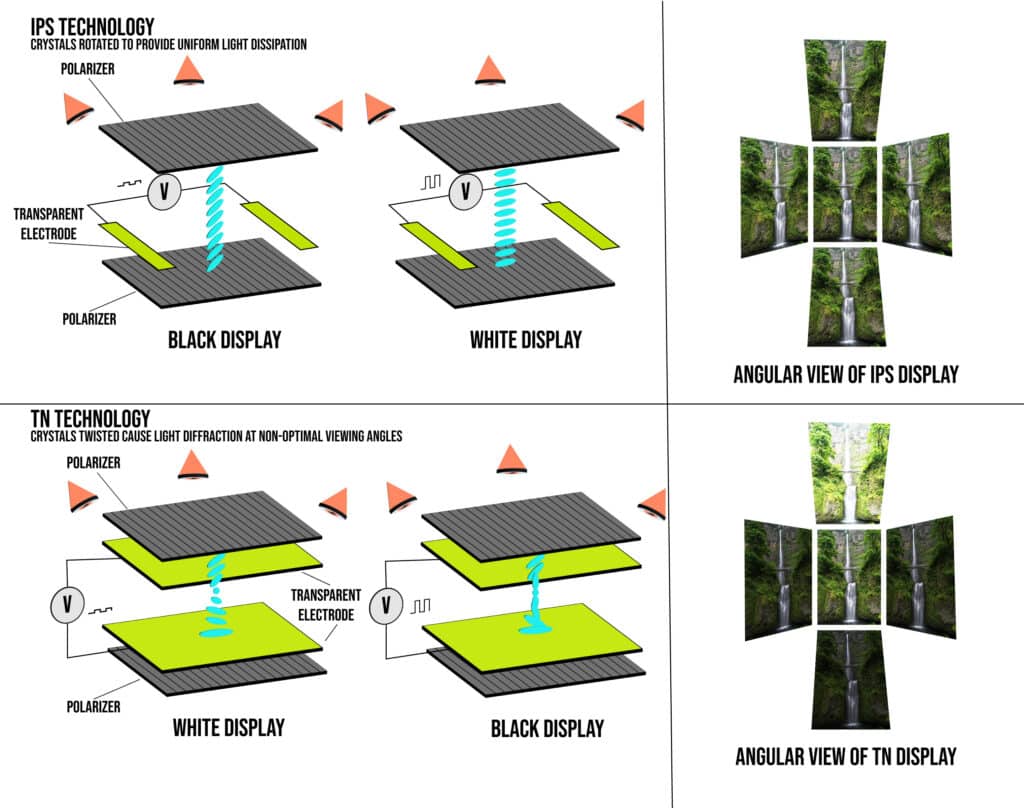In-Plane Switching (IPS) in TFT Displays: A Technological Perspective
16th October 2023Share This Post
Share This Post
This white paper delves into the intricacies of In-Plane Switching (IPS) technology in Thin Film Transistor (TFT) displays. We explore its manufacturing process, the technological advancements that have propelled its popularity, and the benefits it offers over other display technologies.
Introduction
Thin Film Transistor (TFT) displays have revolutionized the way we view digital content. Among the various technologies that have emerged in TFT displays, In-Plane Switching (IPS) stands out for its superior colour accuracy and wide viewing angles. This paper provides an in-depth look at IPS technology from a manufacturing and technological standpoint.
The Birth of IPS Technology
IPS was developed in the late 1990s as a solution to the limitations of the then-dominant Twisted Nematic (TN) displays. TN panels suffered from narrow viewing angles and colour distortions. Specifically, when viewed from off-angles, TN panels often exhibited a colour shift, turning whites into yellows or blues, and making other colours appear washed out or inverted. IPS was designed to address these issues, offering consistent and accurate colours even when viewed from sharp angles.

Manufacturing Process of IPS Displays
The manufacturing of IPS displays involves several intricate steps:
Substrate Preparation
The process begins with the preparation of a glass substrate. This substrate is meticulously cleaned and treated to ensure that it is free from impurities and defects, as these can adversely affect the performance and clarity of the display.
TFT Layering
Thin-film transistors are then layered onto the substrate. These transistors act as switches for each pixel.
IPS displays
In IPS displays, the liquid crystal molecules align themselves parallel to the layers of the display, which is in stark contrast to TN displays where the crystals experience a 90-degree twist in their alignment. The term “In-Plane Switching” derives from this parallel alignment of the liquid crystals within the plane of the display. This parallel alignment ensures that light passing through the liquid crystals is modulated consistently across the display, resulting in uniform colour reproduction and brightness. On the other hand, the twisted alignment in TN displays can lead to variations in how light is modulated, causing colour distortions and limited viewing angles. Colour Filter Addition: A colour filter is added to produce the red, green, and blue subpixels.
Polarizer Attachment
Finally, polarizers are attached to the top and bottom of the assembly. The orientation of these polarizers is crucial to the functioning of the IPS display.
Technological Advancements in IPS
Over the years, IPS technology has seen numerous advancements:
Improved Response Times
Early IPS panels had slower response times, often ranging between 25ms to 40ms. This made them less suitable for fast-paced applications like gaming. However, modern IPS displays have seen significant improvements in this area, with many panels now boasting response times as low as 1ms to 5ms, making them competitive with TN panels, which traditionally held the advantage in this metric.
Enhanced Power Efficiency
Traditional IPS panels, especially those with CCFL (Cold Cathode Fluorescent Lamp) backlights, could consume anywhere from 30W to 50W for a standard 24-inch monitor. With the transition to LED backlights and advancements in liquid crystal design, modern IPS panels have become more energy-efficient, with many 24-inch monitors now consuming between 15W to 25W under typical usage. Additionally, features like adaptive brightness and energy-saving modes in newer models can further reduce power consumption.
Higher Resolution
IPS technology has adapted to the demands of 4K and even 8K resolutions, ensuring crisp and clear images.
Benefits of IPS Technology
In the ever-evolving landscape of display technologies, IPS has carved out a niche for itself due to its distinct advantages. These benefits range from offering wide viewing angles to ensuring superior colour accuracy, making IPS panels a preferred choice for a variety of applications. Here are some of the key benefits:
Wide Viewing Angles
IPS displays offer almost 180-degree viewing angles, ensuring consistent colours and brightness levels from virtually any angle.
Superior Colour Accuracy
IPS panels produce more accurate and consistent colours compared to other technologies.
Better Contrast Ratios
While OLED displays might have deeper blacks, IPS panels offer excellent contrast ratios suitable for most applications.
Challenges and the Road Ahead
While IPS technology has come a long way, it is not without challenges. The quest for even faster response times, better power efficiency, and higher resolutions continues. As OLED and MicroLED technologies gain traction, IPS manufacturers are under pressure to innovate and stay relevant.
Related Content
This case study analyses the application of a specific 4″ 1×1 aspect ratio IPS TFT LCD display in EV charging stations, outlining its key features and benefits.
Conclusion
In-Plane Switching technology has played a pivotal role in elevating the quality of TFT displays. Its manufacturing process, coupled with continuous technological advancements, has made it a preferred choice for professionals and consumers alike. As the display technology landscape evolves, IPS will undoubtedly adapt and continue to be a significant player in the market.
At Relec Electronics, we pride ourselves on being at the forefront of IPS panel technology. With years of expertise and a deep understanding of the nuances of display technologies, we are uniquely positioned to guide our clients in selecting the ideal IPS panel for their specific needs. Our team of engineers work closely with our clients to understand their requirements, ensuring that they receive a product that not only meets but exceeds their expectations. Whether you’re looking for a display for a critical professional application or a consumer product, Relec Electronics is your trusted partner in sourcing the best IPS solutions.
SHARE
sign up for our newsletter
Enter your email address below
LET’S MAKE THIS EASY. CALL 01929 555 700
why choose relec?
-
Faster
Our aim is to get back to you with an initial response within the hour.
-
Attention to detail
We pride ourselves on getting you the right product, at the right price and on time.
-
New ideas
We are constantly looking for latest technology and products for your applications.
-
Beyond standard
It’s not just about the product. Our service goes way beyond the norm.
-
Easy
We want to make your life as simple as it can be. Call us to find out what we can offer.





